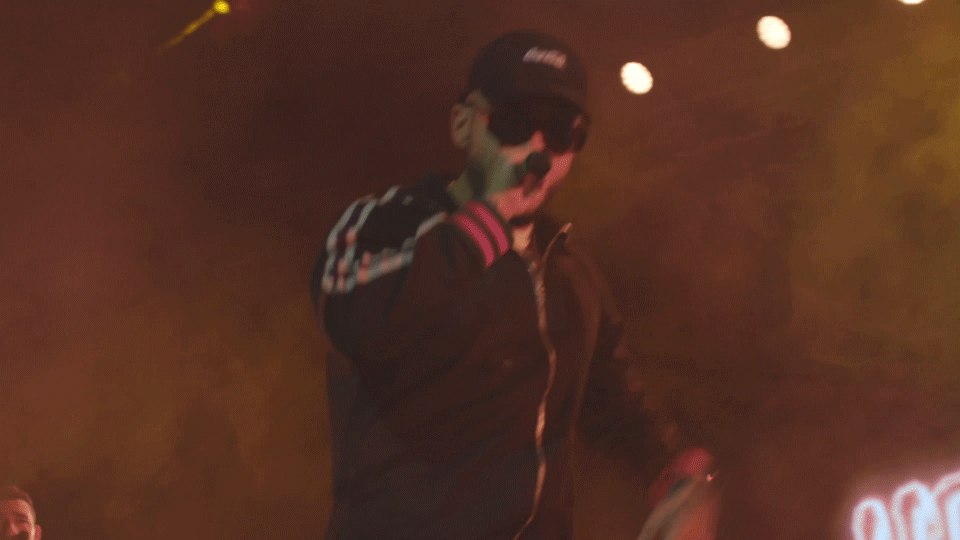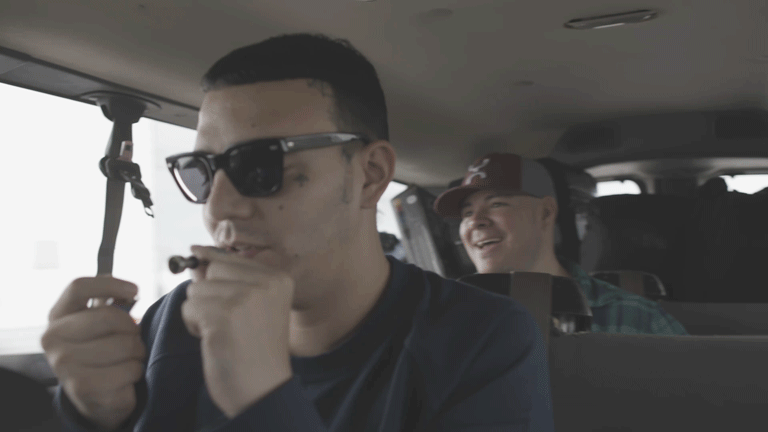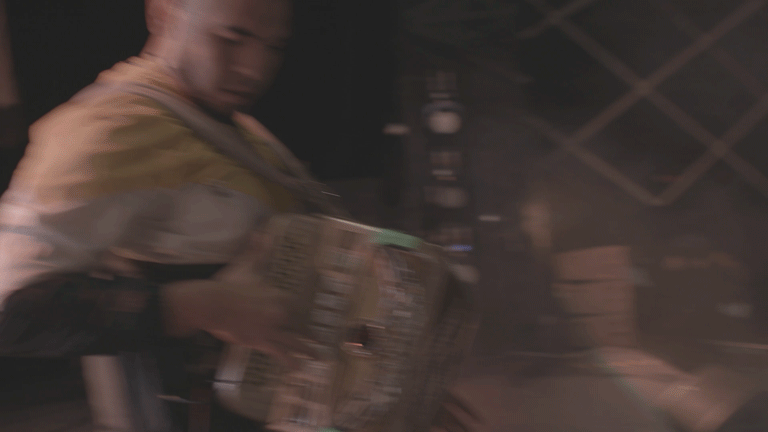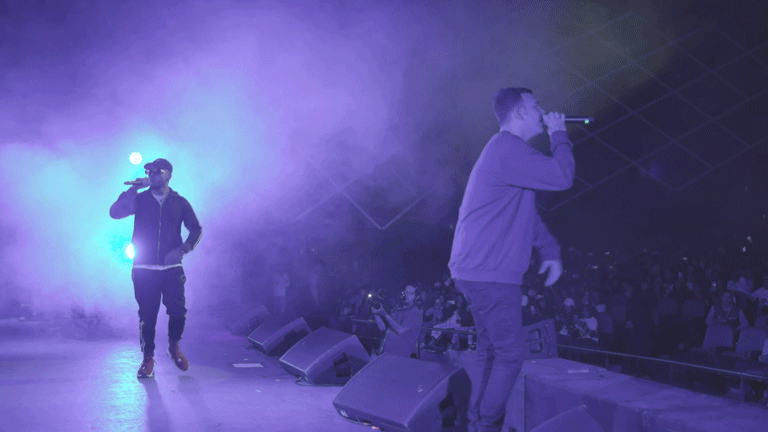Relaxing after the night’s concert, La Plebada’s accordionist Javier Zavaleta is asked if he has finessed the keys for another trap group. He chuckles, “No, this is definitely the first time.”
Zavaleta rarely even listened to urbano music before his current gig, and — though he’s clearly tickled by this new experiment — it should be obvious that he and his bronze-colored Hohner with the silver wing embellishment had never before eased norteño melodies into trap beats. But perhaps it’s safe to say no one had. This particular kind of fusion may never have existed before La Plebada came around.
Times have changed since the October release of the duo’s debut album De Lo Más Solicitado. Powered by ranchstar staccato on tracks like “Botas y Texana,” and breakout hit “El R8,” the duo has become Mexico’s ambassadors from the cresting movement of urbano-regional crossover. The wave is protagonized further north by groups like T3R Elemento and solo artists like Natanael Cano, whose track “El Diablo” was recently remixed by Bad Bunny to cement urbano artists’ corrido infatuation (Ozuna will reportedly take his own stab at the genre on his upcoming album Niburu as well). The Southern California scene, led by labels Rancho Humilde and DEL, is typified by compositions and vocals that tend to be more firmly grounded in traditional Sierreño corrido sound structure, their hustler lifestyle lyricism often the songs’ clearest nod to the trap game.

La Plebada’s decidedly trap beats, which they embellish with traditional norteño instrumentation and surefire hip hop flow, differentiates their sound from these peers. But the space between Buchanan’s mineral and lean is no longer as great as was once thought. It stands to reason that there will be different sonic outcomes of the long-coming urbano-regional cultural fusion.
“That makes us feel good, to see Snoop hanging out to this kind of music,” says Fntxy earlier in the day. The van ride from Mexico City to Toluca, site of the night’s show, takes about 45 minutes. He and Cozy Cuz are taking advantage of the down time to hammer out a “road beat” and opine on how the trap corrido moment came to be.
Snoop Dogg is, of course, one of hip-hop’s early adaptors of corridos, and has done much to raise the genre’s profile among fans that may not necessarily be familiar with their sound. Snoop’s banda love shows Spanish language mastery is not necessary to be a fan. Just check his Instagram videos, like the one the rapper posted of himself moping by a rain-spattered window, lip-synching to Jenni Rivera’s “Envuélte.” But the current urbano and regional crossover moment was forecasted far earlier than Instagram. Early seeds were planted in the late ‘80s and early ‘90s, when fans could buy NWA and Chalino Sánchez’s earliest releases at the same South LA swapmeets.

California is not the only place where corridos and hip hop reverberated from the same speakers. Both Fntxy and Cozy Cuz were born in the coastal Sinaloa farm town of Los Mochis, and the two soon moved to larger Mexican cities; Fntxy to Tijuana and Cozy Cuz to Mexico City. The emcees were raised on MTV Jams and built hip hop careers, eventually uniting under the umbrella of Mexico’s best-known rap crew, Homegrown Entertainment. They became collaborators, and through the course of studio sessions, discovered their shared love of Sinaloan sounds. In Mexico, people have been predicting that urbano-regional fusion would be the next big thing for years. But Fntxy and Cozy Cuz inadvertently found themselves making that prediction a reality. “We always say it was less of a decision than a situation,” says Fntxy.
Precisely that kind of situation is unfurling in the van. “With this and an accordion we can do anything,” announces Cozy Cuz. He’s pulled out his laptop, and cued a darkly cascading trap beat. Someone calls for the tuba, but there’s not enough space in the vehicle to pull out the 35 pound horn. Instead, Cozy cuts up a classical clarinet sample, and the duo start to freestyle, their lyrics ranging from cocaine to cornflakes to jealous emcees.
Later that night at the Toluca show, the surprising synchronicity resulting from this free-wheeling creative process is on display. The emcees careen across the front of the stage, blessing the crowd with their biggest hit to date “La Galliza,” the stoner’s anthem concocted with the help of El Ezquiel a.k.a. viral internet personality Cid Vela (who created another Mexican drug paen in the mid aughts’ “Tachas y Perico”). As La Plebada flexes and stunts, a DJ cues track after track, and the live musicians provide some of the most bombastic musical support ever seen on a trap stage. Bajo sexto player Daniel Flores Medina leans to the 808 beats, tubist Cesár Rosas Martínez showing remarkable agility in dramatic, on-rhythm lunges.
Even if the Toluca crowd is there to see the acts that come after them — La Plebada’s Homegrown peer, rapper Alemán and Argentinian teen trap idol Duki — they get the most dynamic show from the duo from Los Mochis. By the end of the set, most of the audience is out of their seats, dancing to a beat that is at once familiar and brand-new. Still hype after the show, La Plebada and their entourage celebrate another successful gig with a rousing dressing room rendition of Ramon Ayala’s “Tragos Amargos.”
La Plebada’s sound is not the only way the group differs from its SoCal peers. Cozy Cuz and Fntxy don’t stray from lyrics about partying, blunts, and women. But there’s little in their lyrics that exalt the most popular corrido subject, the narcos. That’s not because La Plebada is anti-drug. In past interviews, they’ve acknowledged that like any drug consumer, they do support cartels with their party money, “But I’m not benefiting,” said Cozy Cuz. “So we like to stay to the margin [when it comes to lyrics about narcos].” This is also a personal safety measure. Mexico has seen the slaying of dozens of narcocorrido-singing stars. In March 2017, a member of Grupo Contacto was murdered after being threatened by the Jalisco New Generation Cartel.

Instead, La Plebada reps a rancho glamour that seems of their own making. Where Fntxy is content to give you low key jeans and a tee rap styling, Cozy runs with a more buchón look. He often appears in dashing wide-brimmed cowboy hats, though for the Toluca show he sports a Gucci tracksuit, hi-top red sneakers, and a t-shirt from a Guadalajara streetwear line. Around his neck is a thick gold chain from which a Jesus Malverde pendant – a tribute to a venerated Sinaloa bandit – swings expressively as he delivers his verses onstage. The vibe bridges urban and rural, norteño swag looped into a trap labyrinth. Given the country’s blend of reigning musical influences, it’s no wonder crowds are taking to La Plebada.
“It’s really interesting to see the young people that have been following the group,” says Zavaleta, his hand now grasping not his Hohner but a still-unlit joint. “They’ve forgotten about this stereotype that has been around for awhile that regional music is for people who are out of step. Now, people are starting to listen, to take it on as something that’s valuable to them.”
La Plebada is thrilled to find themselves at this point of contact. “We are part of something that is not stopping,” as Fntxy puts it. Maybe the most important question is not how La Plebada’s trap corridos came to be, but why it took them so long to arrive.








